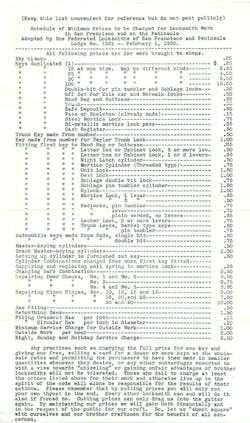TWENTY YEARS AGO
Gerry Finch started a series on the "Language of Masterkeying." Jerry Levine warned against buying low cost "open anything" car lock tools sold by slick telephone salesmen. Harrison Electronics guided us through car alarm installations. Gwen Rickman explained her LJP locksmith placement program. Ledger printed a time guide sorted by vehicle model for removing and replacing auto locks. Ray Baldwin, JLM Wholesale, answered locksmith questions about electric strikes. AAble introduced their Persuader GM lock force tool. Ken Holmlund suggested the planning steps necessary before developing a master key system. Jerry Levine printed a rumor about the amount of cars that would use sidewinder keys. The trickle has become a torrent. Jerry also reported on a new locksmith business started by Adam Weinraub from Pro-Lok. The history of the Schlage Key 'n Keyless was discussed. Mike Cox urged locksmiths to make a time study to be sure they are profitable. David Halls offered suggestions on when to install a maglock. Jerome Andrews showed the new Lori Peaks lock cylinder. Milt Wolferseder drilled open a Mosler wall safe. Charles Cole provided charts for progressing Ford 10-cut keys.
TEN YEARS AGO
The ALOA convention was held in Baltimore, MD in 2001. Gale Johnson showed how to service key-change Lefebure bank teller locks. Gale Johnson also described how CCL wafer locks can be masterkeyed. Jerry Levine installed Locknetics #993 electronic components into a Von Duprin #99 exit device. Mike Ferrill interviewed the institutional locksmith staff at Notre Dame university. Billy Edwards reported on the changes at Master Lock as tolerances were tighted on ther keyway. Dale Bowman introduced the Medeco 'intruder' classroom lockset. Locksmith Ledger printed the top 20 products for 2000 as chosen by subscribers. Wade Landrum interviewed Accurate Security Professionals, a successful locksmith business in San Diego, CA. Tom Gillespie offered tips on running a locksmith business. Tony Vigil, High Tech Tools, provided pictures on opening a Mitsubishi Montero Sport. Richard Formica worked on a Cadillac Escalade with lost keys while Tiny took on a Mazda 626. Jerry levine installed a Sargent T-Zone lever lock and installed a Detex Value Series exit alarm. Dick Zunkel showed the tools and knowhow necessary to troubleshoot electronic hardware. LAB showed formulas for determining control key cuts for Best A2, A3 & A4 systems.
PRICING GUIDE, CIRCA 1938
Ever wonder how much prices have increased over the last 70-something years? Looking through our archives, Locksmith Ledger contributor Tom Gillespie came upon a pricing guide from a San Francisco, Calif., locksmith shop in 1938.
The heading is "Schedule of Minimum Prices to be Charged for Locksmith Work in San Francisco and on the Peninsula." Here are some excerpts.
- The most expensive service listed was Repairing Rixson Hinges, $10.
- A customer paid 20 cents for a duplicate key, with discounts for ordering quantities of 12 or more at the same time.
- A trunk key made by number cost 50 cents.
- Fitting keys for a Letter box or cabinet lock keys was 50-75 cents.
- Fitting keys for a Best lock was $1, while fitting keys for a Schlage pin tumbler cylinder was $1.50.
- Master keying of cylinders ocst 50 cents, or $1 for grand master keying.
- Changing a safe combination was $3.50.
- Automobile keys made by code were 50 cents for single-bit or 75 cents for double-bit.
- The minimum service charge for outside work was $1, with a $2.50 additional charge for night or weekend calls.
It appears that this list of minimum prices applied to all members of the Federated Locksmiths of San Francisco and Peninsula, as adopted Feb. 3, 1938.
"Any practices such as charging the full price for one key and giving one free, selling a card for a dozen or more keys at the wholesale rates and permitting the purchaser to have them made in smaller quantities whenever they desire, or any other subterfuge resorted to with a view towards 'chiseling' or gaining unfair advantages of brother locksmiths will not be tolerated. Those who fail to charge at least the prices listed above for their work and otherwise live up to the spirit of the code will alone be responsible for the results of their actions. Please remember that by cutting prices, you will only cut your own throat in the end. Every other locksmith can and will do it also if forced to. Cutting prices can only drag us into the gutter again. By maintaining our prices, we will gain both financially and in the respect of the public for our craft. So let us 'shoot square' with ourselves and our brother craftsmen for the benefit of all concerned."






